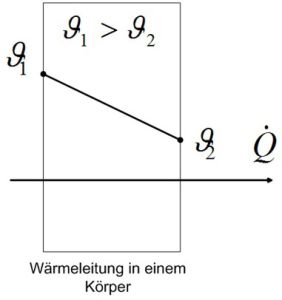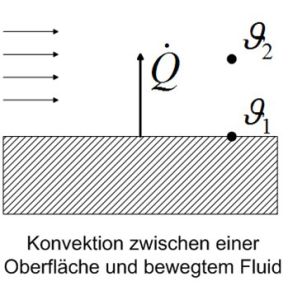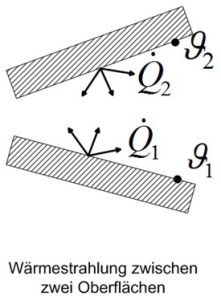Mechanism of heat transfer
Thermal heat transfer specifies the transportation of thermal energy due to a temperature difference. The transported thermal energy is also referred to as heat. Heat transfer belongs to three categories, which are described below.
- Heat conduction defines the flowing of thermal energy due to a temperature difference.

- Heat transfer between a wall and flowing fluids is defined as convection.

- Heat radiation is defined as electromagnetic waves, which transfer heat from one surface to another.

Heat conduction
Heat conduction defines the flowing of thermal energy (heat) due to a temperature difference within a medium. In accordance with the second law of thermodynamics, the heat conduction is always taken place towards lower temperatures. In figure 1 the temperature T1 is higher than T2. Therefore the thermic flow for all three types of heat transfer is towards temperature T2. According to Fourier the law of heat conduction says:

In this case, the heat flow density q is calculated from the product of negative thermal conductivity and the temperature gradient degrees T perpendicular to the cross-sectional area.
Convection
The heat transfer between a wall and flowing fluids is defined as convection. This can be distinguished into free and forced convection. In forced convection, the flow is generated by a pressure difference. The free convection is generated by a temperature difference and consequent buoyancy forces due to density differences. The transferred heat flux density results from:

At this juncture, alpha stands for the heat transfer coefficient, TF for the fluid temperature and TW for the wall temperature.
Heat radiation
The Stefan Boltzmann law forms the basis of heat radiation. This states that every body whose temperature is above the absolute zero of the temperature emits heat radiation. For this purpose, in contrast to heat conduction and convection, no material medium is necessary. Thermal radiation is electromagnetic waves that transfer heat from one surface to another. Furthermore, the Stefan Boltzmann law describes how much thermal radiation a body emits. If two surfaces are in contact with each other, the heat flow generated by radiation is transferred from body 1 to body 2:

Here, ε12 stands for the resulting emissivity, σs for the Stefan-Boltzmann constant, A1 for the radiating surface and T for the temperature of the body.
Heat radiation without the visible light component is called infrared radiation. Further information about infrared/heat radiation can be found here.